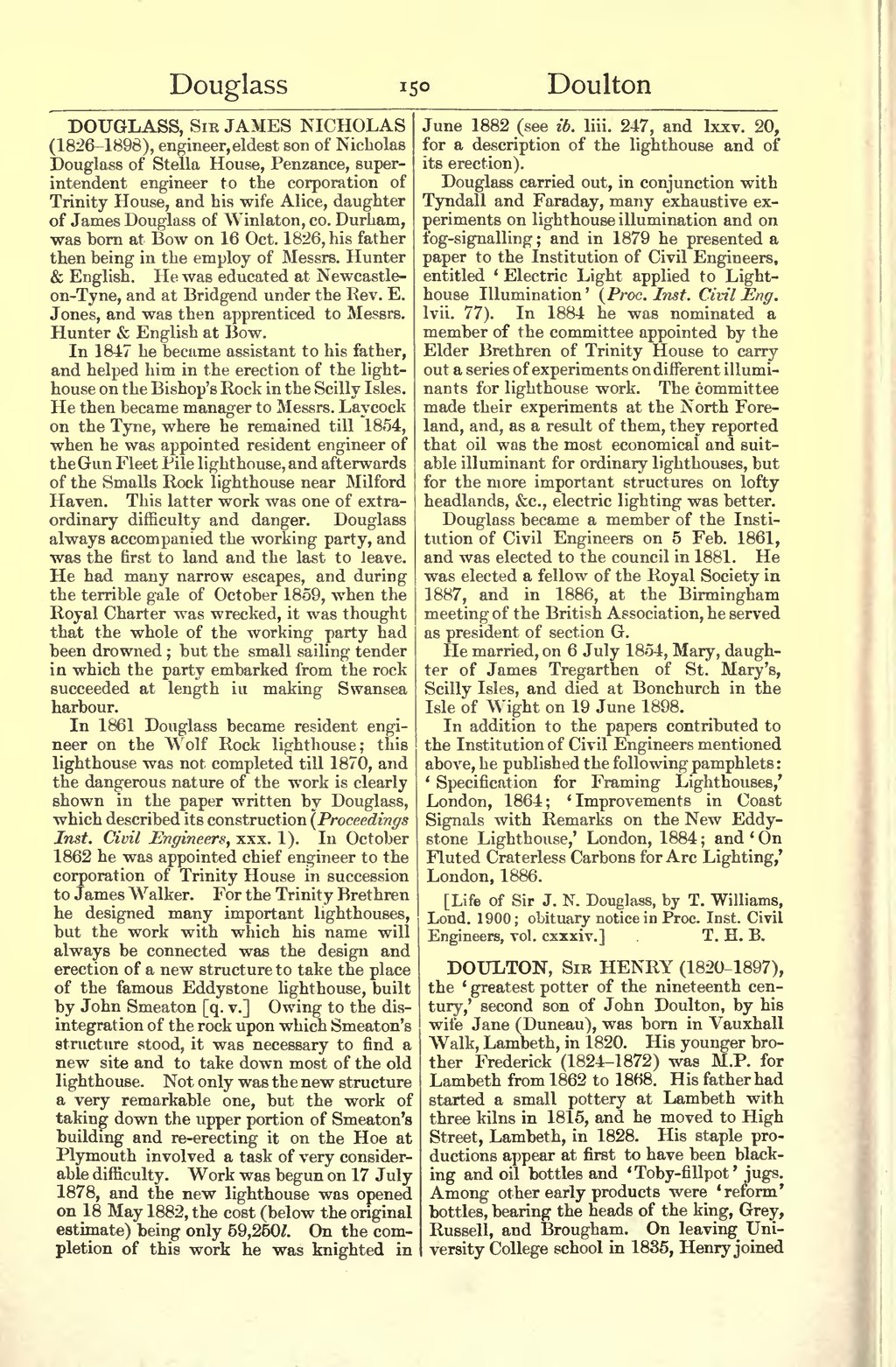DOUGLASS, Sir JAMES NICHOLAS (1826–1898), engineer, eldest son of Nicholas Douglass of Stella House, Penzance, super-intendent engineer to the corporation of Trinity House, and his wife Alice, daughter of James Douglass of Winlaton, co. Durham, was born at Bow on 16 Oct. 1826, his father then being in the employ of Messrs. Hunter & English. He was educated at Newcastle-on-Tyne, and at Bridgend under the Rev. E. Jones, and was then apprenticed to Messrs. Hunter & English at Bow.
In 1847 he became assistant to his father, and helped him in the erection of the lighthouse on the Bishop's Rock in the Scilly Isles. He then became manager to Messrs. Laycock on the Tyne, where he remained till 1854, when he was appointed resident engineer of the Gun Fleet Pile lighthouse, and afterwards of the Smalls Rock lighthouse near Milford Haven. This latter work was one of extraordinary difficulty and danger. Douglass always accompanied the working party, and was the first to land and the last to leave. He had many narrow escapes, and during the terrible gale of October 1859, when the Royal Charter was wrecked, it was thought that the whole of the working party had been drowned; but the small sailing tender in which the party embarked from the rock succeeded at length in making Swansea harbour.
In 1861 Douglass became resident engineer on the Wolf Rock lighthouse; this lighthouse was not completed till 1870, and the dangerous nature of the work is clearly shown in the paper written by Douglass, which described its construction (Proceedings Inst. Civil Engineers, xxx. 1). In October 1862 he was appointed chief engineer to the corporation of Trinity House in succession to James Walker. For the Trinity Brethren he designed many important lighthouses, but the work with which his name will always be connected was the design and erection of a new structure to take the place of the famous Eddystone lighthouse, built by John Smeaton [q. v.] Owing to the disintegration of the rock upon which Smeaton's structure stood, it was necessary to find a new site and to take down most of the old lighthouse. Not only was the new structure a very remarkable one, but the work of taking down the upper portion of Smeaton's building and re-erecting it on the Hoe at Plymouth involved a task of very considerable difficulty. Work was begun on 17 July 1878, and the new lighthouse was opened on 18 May 1882, the cost (below the original estimate) being only 59,250. On the completion of this work he was knighted in June 1882 (see ib. liii. 247, and lxxv. 20, for a description of the lighthouse and of its erection).
Douglass carried out, in conjunction with Tyndall and Faraday, many exhaustive experiments on lighthouse illumination and on fog-signalling; and in 1879 he presented a paper to the Institution of Civil Engineers, entitled 'Electric Light applied to Lighthouse Illumination' (Proc. Inst. Civil Eng. lvii. 77). In 1884 he was nominated a member of the committee appointed by the Elder Brethren of Trinity House to carry out a series of experiments on different illuminants for lighthouse work. The committee made their experiments at the North Foreland, and, as a result of them, they reported that oil was the most economical and suitable illuminant for ordinary lighthouses, but for the more important structures on lofty headlands, &c., electric lighting was better.
Douglass became a member of the Institution of Civil Engineers on 5 Feb. 1861, and was elected to the council in 1881. He was elected a fellow of the Royal Society in 1887, and in 1886, at the Birmingham meeting of the British Association, he served as president of section G.
He married, on 6 July 1854, Mary, daughter of James Tregarthen of St. Mary's, Scilly Isles, and died at Bonchurch in the Isle of Wight on 19 June 1898.
In addition to the papers contributed to the Institution of Civil Engineers mentioned above, he published the following pamphlets: 'Specification for Framing Lighthouses,' London, 1864; 'Improvements in Coast Signals with Remarks on the New Eddystone Lighthouse,' London, 1884; and 'On Fluted Craterless Carbons for Arc Lighting,' London, 1886.
[Life of Sir J. N. Douglass, by T. Williams, Lond. 1900; obituary notice in Proc. Inst. Civil Engineers, vol. cxxxiv.]
DOULTON, Sir HENRY (1820–1897), the 'greatest potter of the nineteenth century,' second son of John Doulton, by his wife Jane (Duneau), was born in Vauxhall Walk, Lambeth, in 1820. His younger brother Frederick (1824-1872) was M.P. for Lambeth from 1862 to 1868. His father had started a small pottery at Lambeth with three kilns in 1815, and he moved to High Street, Lambeth, in 1828. His staple productions appear at first to have been blacking and oil bottles and 'Toby-fillpot' jugs. Among other early products were 'reform' bottles, bearing the heads of the king, Grey, Russell, and Brougham. On leaving University College school in 1835, Henry joined
